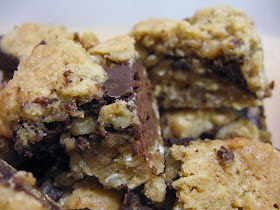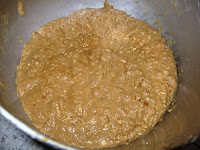My original plan here was to make a toasted marshmallow ice cream. I've been hearing a lot of buzz about the flavor recently and it sounded worth trying. But I didn't want to just buy a bag of marshmallow, toast them, and then mix them into vanilla ice cream. That's kind of dull and it wouldn't have a very good texture. The places that make toasted marshmallow ice cream and milkshakes have a special process to create kind of a slurry with that flavor that lets them create a smooth mix. But when I looked around I found that the secret processes they use haven't leaked out yet, at least not to anyplace I could find.
So, plan B was malted marshmallow. Malt flavored ice cream with a marshmallow swirl. For a good while I was planning to make a batch of marshmallow sauce and a batch of malted whipped cream, fold them together and call it done. And if I had two bowls for my mixer so I could keep one chilled for the cream while working on the marshmallow I probably would have gone that way. I've seen a fair number of churn-free ice cream recipes using that sort of method and I'm curious as to what sort of texture you can get. But I haven't got two bowls so instead I decided to make a batch of malted milk ice cream in the churn and then swirl in the marshmallow sauce.
Since I

needed an egg white for the marshmallow I decided to go back to the custard style for the ice cream. Since I didn't need to infuse any flavor into the dairy, it was a pretty simple recipe. I mixed 9 Tablespoons of malted milk with four egg yolks, added that to two cups of cream and one cup milk and heated until the mixture reached 170 degrees and coated the back of a spoon.
Once it had cooled a bit, I tasted it and wasn't entirely happy so I added a dash of salt and a half teaspoon of vanilla. It still wasn't quite doing it for me so I whisked in 3/4 of an ounce of Dutch process cocoa. That's a bit low for three cups of dairy, but I wanted the malt to be a stronger flavor than the chocolate. That worked a bit too well, so if you're interested in making something similar, you should cut the malt back to 6 Tablespoons and boost the cocoa to a full ounce. And that still didn't quite do it so I added 1/4 cup of sugar and then the flavors started to pop.
The marshmallow sauce was not so easy. Unfortunately, I had such difficulty that I was unable to take pictures as I went along. As I wrote above, I didn't want to start with a bag of marshmallows or a jar of Fluff, so I used David Lebovitz's recipe which was the only one I could find that started from scratch. He uses:
3/4 cup cold water
1 envelope unflavored powdered gelatin
1/4 cup sugar
1/2 cup light corn syrup (I ran out and used half agave nectar. Didn't seem to hurt.)
1 large egg white
1 big pinch of salt
1 teaspoon vanilla extract (which I thought I forgot, but since the result tastes of vanilla, maybe I didn't)
He says to sprinkle the gelatin over 1/2 cup of cold water and set aside, start heating the sugar and corn syrup with the rest of the water and only beginning to whip the egg white in a stand mixer when the sugar mixture has reached 225 degrees.
I've got a pretty standard stand mixer and the whisk attachment barely reached one little egg white at the bottom of the bowl so it had a heck of a time whipping it. Lebovitz expects the sugar to reach 240 degrees (soft ball stage) at the same time as the meringue reaches stiff peaks, but I found that to be way off. My egg had barely started. I turned down the heat, but the sugar got up to 250 degrees (firm ball) and developed a little color, before the meringue got to soft peaks and I decided it was close enough.
The next step was to slowly pour the sugar syrup into the mixing bowl. Mine ended up clumping and splattering all over the place. I scraped down the bowl and turned the splatter into another clump. Eventually I got it all incorporated, but it was a serious struggle.

The final step was to pour the gelatin into the warm pot to melt it down and dissolve any remaining sugar and then pour into into the mixing bowl as well continuing to whip until the mixture cools to room temperature and thickens. Well, at Miami room temperature, it doesn't thicken.

To make matters more complicated, while I was dealing with all this, I was also churning the ice cream. The mix was a little on the thick side so I had some trouble with it freezing up solid along the sides and bottom of the churn, but once the bucket had warmed up a little, that

sorted itself and the mixture smoothed out and froze up well if a little on the firm side. I was hopeful that meant it wouldn't melt readily as I mixed it with the warm marshmallow sauce, but I'm afraid it did and they blended together instead of swirling.
I had more marshmallow than I wanted to mix in so I poured the rest over the top

before putting the container in the freezer.
Here it is the next day. You can see the marshmallow strata has turned rubbery. Not good at all, so I scraped it out and melted it down. That worked well at first, but after a while it lost its foaminess and devolved into an increasingly thick sauce as it cooled and the gelatin took hold.

The sauce, since I let the sugar get 10 degrees too hot, has a caramel note to it that I can't say I mind at all. It also tastes of vanilla which I'm pretty sure I forgot to put in so I'm not sure how that happened, and, at least after it melted down, a good hit of salt. Also good with caramel so not a problem.
The cocoa I added to the malt ice cream tastes more like cocoa than chocolate so the result tastes like it ought to be chalky in texture even though it isn't. Does that make any sense? It's not a conventional chocolate malt flavor is what I'm getting at here. I'm surprised people accepted it as readily as they did, really. The marshmallow sauce that I hoped to swirl into the ice cream blended instead and tempered the strong malt flavor. It's still not all that sweet but I think that works very well with the intense sweetness of the marshmallow sauce.

A spoonful of the ice cream with the sauce is full of interesting contrasts in levels of sweetness, of flavors, in textures and in temperatures. And it's also yummy, so despite the difficulties, at the end, success all around.
Oh, one last thing. Apparently July is ice cream month and there's an Ice Cream Social blog meme thing. I'm supposed to link back to
ScottySnacks,
SavortheThyme and
Tangled Noodle. You can go to any of those three to see what other folks have done for the challenge. There are some interesting ideas there, so it's worth looking around if you're bored with my ice cream creations.
 flour, baking powder, and salt into a large mixing bowl. Cut in the butter with a knife or pastry cutter until the mixture forms ½-inch pieces. [I just used my fingers and the texture I got at the end was more sandy than anything I'd call "pieces". Could someone who understands baking better than I do please explain the significance of the difference?]
flour, baking powder, and salt into a large mixing bowl. Cut in the butter with a knife or pastry cutter until the mixture forms ½-inch pieces. [I just used my fingers and the texture I got at the end was more sandy than anything I'd call "pieces". Could someone who understands baking better than I do please explain the significance of the difference?] the eggs, ½ cup of the cream, and cheddar. Mix by hand [well, by whisk held in your hand] until just combined. Fold in the scallions [or chives] and cooled bacon. [This I did with my hands.]
the eggs, ½ cup of the cream, and cheddar. Mix by hand [well, by whisk held in your hand] until just combined. Fold in the scallions [or chives] and cooled bacon. [This I did with my hands.] the wedges to a baking sheet lined with parchment. Brush with the remaining cream and bake for 20 to 25 minutes, [I went all the way to 30 minutes, but baking in my oven often goes long.] until the scones are golden brown on the top and bottom (you'll have to lift them off the baking sheet a bit to check underneath).
the wedges to a baking sheet lined with parchment. Brush with the remaining cream and bake for 20 to 25 minutes, [I went all the way to 30 minutes, but baking in my oven often goes long.] until the scones are golden brown on the top and bottom (you'll have to lift them off the baking sheet a bit to check underneath).














































